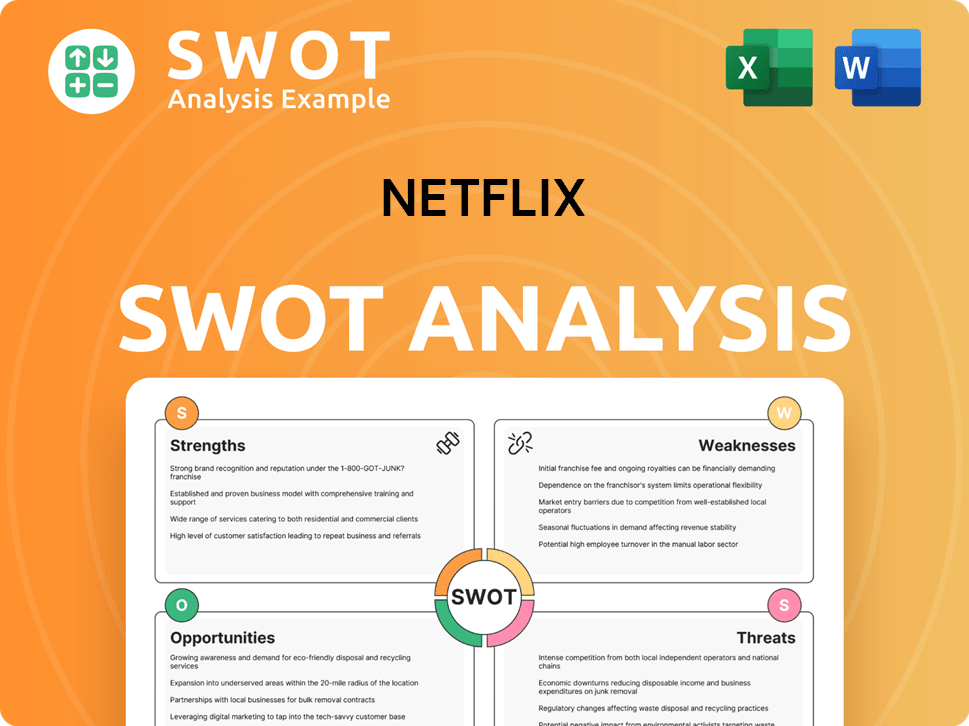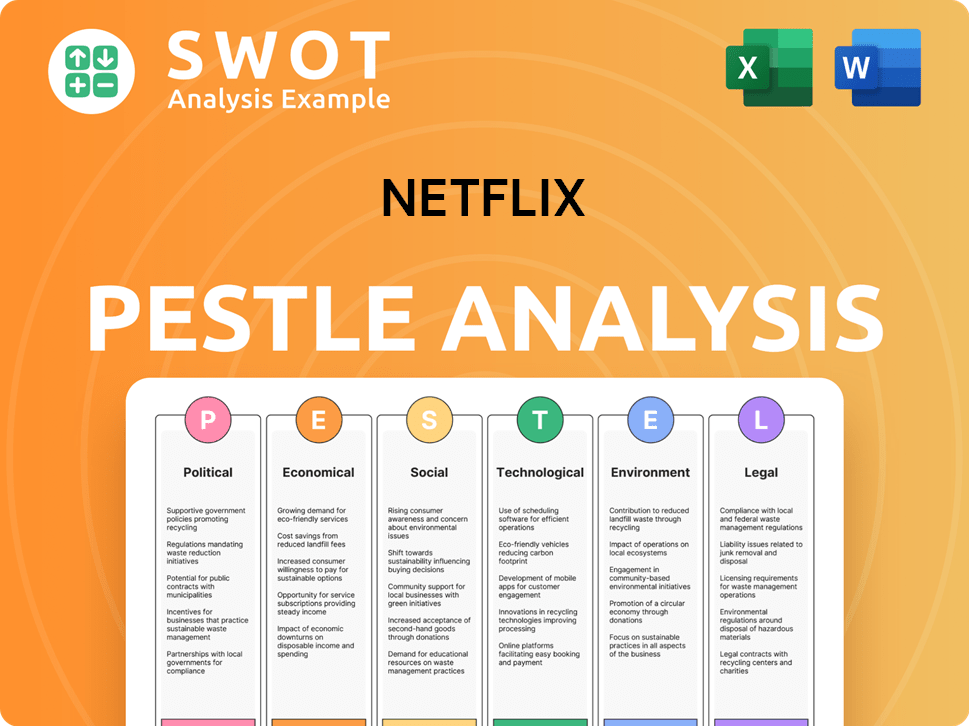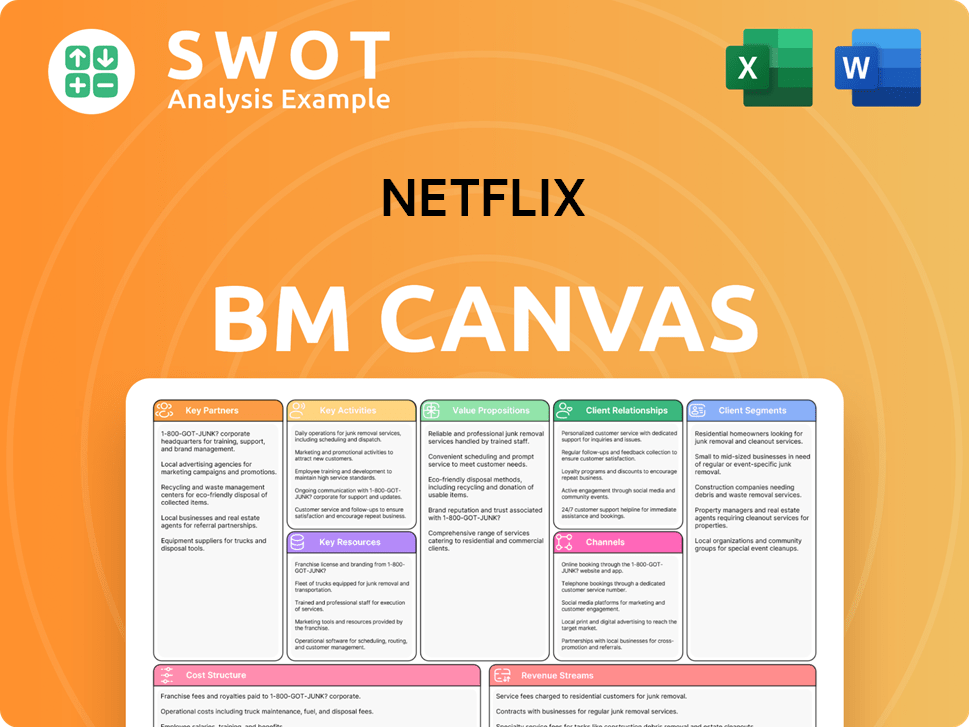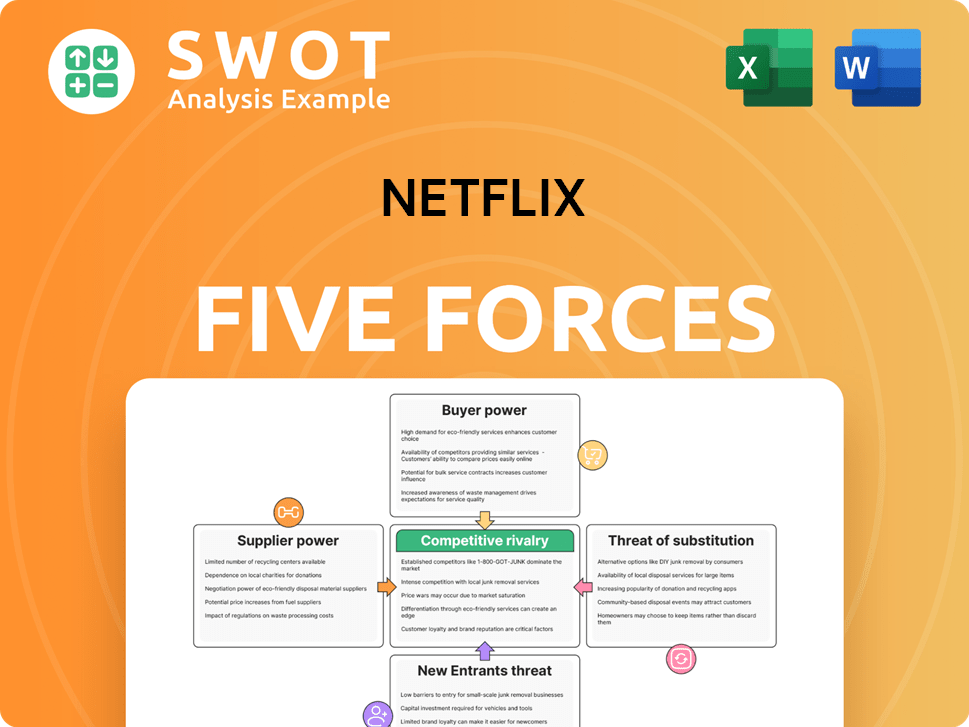Netflix Bundle
Who Really Calls the Shots at Netflix?
Understanding the Netflix SWOT Analysis is crucial, but have you ever wondered who truly steers this entertainment giant? The Netflix ownership structure holds the key to its strategic decisions and future success. Unraveling the Netflix parent company and its stakeholders provides invaluable insights for investors and industry watchers alike.

This exploration into Netflix ownership will delve into the company's evolution, from its founding by Reed Hastings and Marc Randolph to its current status as a global streaming leader. We'll examine the influence of Netflix shareholders, the roles of key Netflix executives, and the overall Netflix structure that shapes its operations. Knowing Who owns Netflix is vital for anyone seeking to understand the dynamics of the entertainment industry.
Who Founded Netflix?
The company was co-founded by Reed Hastings and Marc Randolph in 1997. The early days saw both founders playing crucial roles in shaping the company's direction. While specific initial equity splits are not publicly available, Hastings' initial investment of $2.5 million was a key factor in launching the venture.
Marc Randolph served as the first CEO, with Hastings later taking over the leadership. Early backing came from venture capital firms that were essential in scaling the DVD-by-mail service and establishing the initial infrastructure. The company’s journey began with a clear vision and the financial backing needed to turn the founders’ ideas into reality.
Early investments were critical for the company's growth. Institutional Venture Partners (IVP) invested $1 million in 1998. In 1999, Groupe Arnault, Bernard Arnault's holding company, invested $30 million. These investments were instrumental in the company's expansion. While specific details on vesting schedules or buy-sell clauses from this early period are not widely disclosed, such agreements are standard in startup funding to ensure founder commitment and provide investor protection.
Reed Hastings and Marc Randolph co-founded the company in 1997.
Hastings provided the initial seed money of $2.5 million.
Marc Randolph was the first CEO, followed by Reed Hastings.
Institutional Venture Partners (IVP) and Groupe Arnault were early investors.
IVP invested $1 million in 1998, and Groupe Arnault invested $30 million in 1999.
Marc Randolph left the company in 2003, remaining on the board until 2004.
The early ownership structure of the company was shaped by the contributions of its founders and the investments from early backers. The initial capital from Reed Hastings and the subsequent funding rounds from venture capital firms like IVP and Groupe Arnault set the stage for the company's growth. Understanding the early ownership dynamics provides insight into the company's evolution. For more details, you can explore the Competitors Landscape of Netflix.
The company's initial funding and leadership were crucial.
- Reed Hastings and Marc Randolph were the co-founders.
- Hastings provided the initial seed money.
- Early investments came from venture capital firms.
- Marc Randolph served as the first CEO.
Netflix SWOT Analysis
- Complete SWOT Breakdown
- Fully Customizable
- Editable in Excel & Word
- Professional Formatting
- Investor-Ready Format

How Has Netflix’s Ownership Changed Over Time?
The evolution of Netflix's ownership structure reflects its journey from a startup to a global entertainment giant. Initially, the company was primarily controlled by its founders and early investors. However, the initial public offering (IPO) on May 29, 2002, marked a significant turning point. The IPO, priced at $15.00 per share (or $1.07 after splits), raised approximately $82.5 million, establishing an initial market capitalization of around $300 million. This event opened the door for broader public and institutional investment, gradually shifting the ownership landscape.
Over time, subsequent stock offerings and the company's growth diluted the stakes of the founders and early investors. As of early 2025, the ownership is dominated by institutional investors. This shift has profoundly influenced the company's strategic direction, emphasizing subscriber growth, content investment, and profitability to meet the expectations of large-scale investors. Understanding the Netflix ownership and Netflix structure is crucial for grasping its operational dynamics and future trajectory.
| Key Event | Date | Impact on Ownership |
|---|---|---|
| Initial Public Offering (IPO) | May 29, 2002 | Transitioned from private to public ownership, introducing public and institutional investors. |
| Subsequent Stock Offerings | Ongoing | Diluted the ownership of founders and early investors, increasing the proportion held by institutional investors. |
| Company Growth and Expansion | Ongoing | Attracted significant institutional investment, further diversifying the shareholder base and influencing strategic decisions. |
The major stakeholders in Netflix ownership include prominent institutional investors. As of December 31, 2024, Vanguard Group Inc. held approximately 8.2% of the shares, and BlackRock Inc. held around 6.9%. Other significant institutional investors include Fidelity Management & Research Company, Capital Research Global Investors, and State Street Global Advisors. While Reed Hastings, the co-founder and former CEO, still retains a substantial individual stake, his percentage ownership has decreased over time. As of early 2025, Reed Hastings holds approximately 1.5% of the outstanding shares. This structure highlights the influence of institutional investors on the company's strategic decisions.
The ownership of Netflix parent company has evolved significantly since its IPO.
- Institutional investors hold the majority of shares.
- Vanguard and BlackRock are among the largest shareholders.
- Reed Hastings remains a significant individual shareholder.
- The shift to institutional ownership influences strategic decisions.
Netflix PESTLE Analysis
- Covers All 6 PESTLE Categories
- No Research Needed – Save Hours of Work
- Built by Experts, Trusted by Consultants
- Instant Download, Ready to Use
- 100% Editable, Fully Customizable

Who Sits on Netflix’s Board?
As of early 2025, the board of directors at the streaming giant includes a mix of experienced leaders and independent members. Reed Hastings, the Co-Founder and Chairman, continues to hold a significant role. Ted Sarandos and Greg Peters, serving as Co-CEOs, are also on the board. The board benefits from independent directors with expertise in technology, media, and finance, ensuring diverse perspectives in decision-making. This structure helps guide the company's strategic direction and maintain its position in the competitive entertainment industry. Understanding the Netflix ownership structure is key to grasping how the company operates.
The board's composition reflects a commitment to both continuity and fresh perspectives. While specific board seats don't explicitly represent major shareholders, the board's fiduciary duties ensure that the interests of large institutional investors are considered. The board oversees key areas such as content investments, global expansion, and financial performance, all of which align with the interests of its diverse shareholder base. The board's decisions are crucial in shaping the future of the company and its ability to compete in the dynamic media landscape. The Netflix parent company structure is designed to support these strategic goals.
| Board Member | Title | Key Role |
|---|---|---|
| Reed Hastings | Co-Founder & Chairman | Provides strategic oversight and guidance |
| Ted Sarandos | Co-CEO | Leads content strategy and operations |
| Greg Peters | Co-CEO | Oversees product, technology, and global expansion |
Netflix operates with a one-share-one-vote structure, meaning each common share typically has one vote. There are no special founder shares with outsized voting rights. This democratic voting structure ensures that major decisions reflect the collective will of the shareholder base, including large institutional investors. The company's governance focuses on strategic content investments and financial performance, aligning with the interests of its diverse shareholder base. The Netflix structure promotes accountability and transparency.
The board of directors at Netflix includes founders and executives with independent members. This structure ensures a balance of experience and fresh perspectives. The company's leadership team is focused on strategic growth and shareholder value.
- Reed Hastings, Ted Sarandos, and Greg Peters are key figures.
- The board oversees content investments and global expansion.
- Netflix uses a one-share-one-vote system.
- The company's governance aligns with shareholder interests.
Netflix Business Model Canvas
- Complete 9-Block Business Model Canvas
- Effortlessly Communicate Your Business Strategy
- Investor-Ready BMC Format
- 100% Editable and Customizable
- Clear and Structured Layout

What Recent Changes Have Shaped Netflix’s Ownership Landscape?
In the past few years, the Netflix ownership structure has largely remained consistent, with institutional investors continuing to hold a significant portion of the shares. The company has been actively involved in share buybacks, with approximately $10 billion authorized for repurchases as of early 2024. These buybacks have the effect of increasing the ownership percentage of existing shareholders incrementally. No major shifts in ownership, such as large-scale mergers or acquisitions, have occurred during this period.
The trend of increasing institutional ownership is common among large, publicly traded companies like Netflix. While the founders' ownership has naturally diluted over time due to the company's growth and public offerings, they still maintain a substantial stake. The impact of activist investors has been limited, likely due to Netflix's strong market position and consistent financial performance. Public statements from Netflix and analysts continue to focus on subscriber growth, revenue diversification through advertising, and content strategy, which indirectly influence investor sentiment and ownership stability. There have been no public announcements regarding potential privatization or significant changes in the company's public listing status.
| Metric | Details | Data Source (Approximate) |
|---|---|---|
| Institutional Ownership | Represents a significant portion of Netflix's shares | Most recent filings |
| Share Repurchase Program | Approximately $10 billion authorized for buybacks | Early 2024 announcements |
| Founder Ownership | Significant, but diluted over time | Public filings |
Institutional investors are the primary holders of Netflix shares, reflecting a trend seen in many large public companies. Share buybacks have been a key strategy, increasing the ownership stake of existing shareholders. The founders remain significant shareholders, even with dilution due to company growth.
The market position and financial performance of Netflix have limited the influence of activist investors. Public statements about subscriber growth and content strategy indirectly affect investor sentiment. There have been no announcements regarding privatization or changes in the company's public listing.
The ownership structure of Netflix has remained relatively stable in recent years. Share buybacks have been a consistent feature, returning value to shareholders. Founder ownership, while diluted, is still a key aspect of the company's structure.
Continued focus on subscriber growth, revenue diversification, and content strategy will likely influence investor sentiment. The company's performance and market position will continue to shape its ownership dynamics. No major changes in public listing status are anticipated.
Netflix Porter's Five Forces Analysis
- Covers All 5 Competitive Forces in Detail
- Structured for Consultants, Students, and Founders
- 100% Editable in Microsoft Word & Excel
- Instant Digital Download – Use Immediately
- Compatible with Mac & PC – Fully Unlocked

Related Blogs
- What are Mission Vision & Core Values of Netflix Company?
- What is Competitive Landscape of Netflix Company?
- What is Growth Strategy and Future Prospects of Netflix Company?
- How Does Netflix Company Work?
- What is Sales and Marketing Strategy of Netflix Company?
- What is Brief History of Netflix Company?
- What is Customer Demographics and Target Market of Netflix Company?
Disclaimer
All information, articles, and product details provided on this website are for general informational and educational purposes only. We do not claim any ownership over, nor do we intend to infringe upon, any trademarks, copyrights, logos, brand names, or other intellectual property mentioned or depicted on this site. Such intellectual property remains the property of its respective owners, and any references here are made solely for identification or informational purposes, without implying any affiliation, endorsement, or partnership.
We make no representations or warranties, express or implied, regarding the accuracy, completeness, or suitability of any content or products presented. Nothing on this website should be construed as legal, tax, investment, financial, medical, or other professional advice. In addition, no part of this site—including articles or product references—constitutes a solicitation, recommendation, endorsement, advertisement, or offer to buy or sell any securities, franchises, or other financial instruments, particularly in jurisdictions where such activity would be unlawful.
All content is of a general nature and may not address the specific circumstances of any individual or entity. It is not a substitute for professional advice or services. Any actions you take based on the information provided here are strictly at your own risk. You accept full responsibility for any decisions or outcomes arising from your use of this website and agree to release us from any liability in connection with your use of, or reliance upon, the content or products found herein.